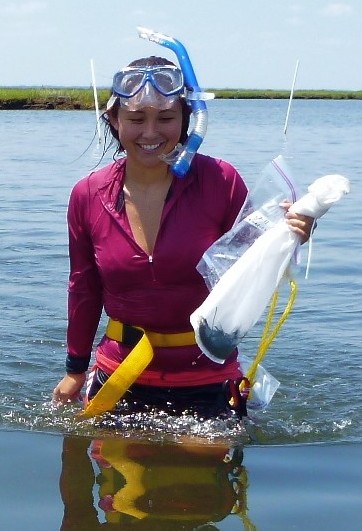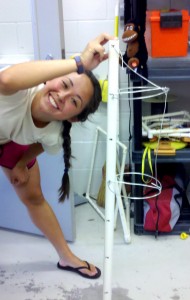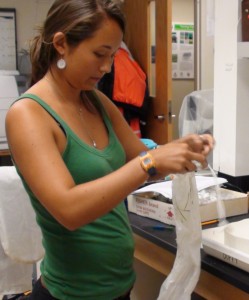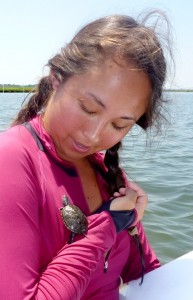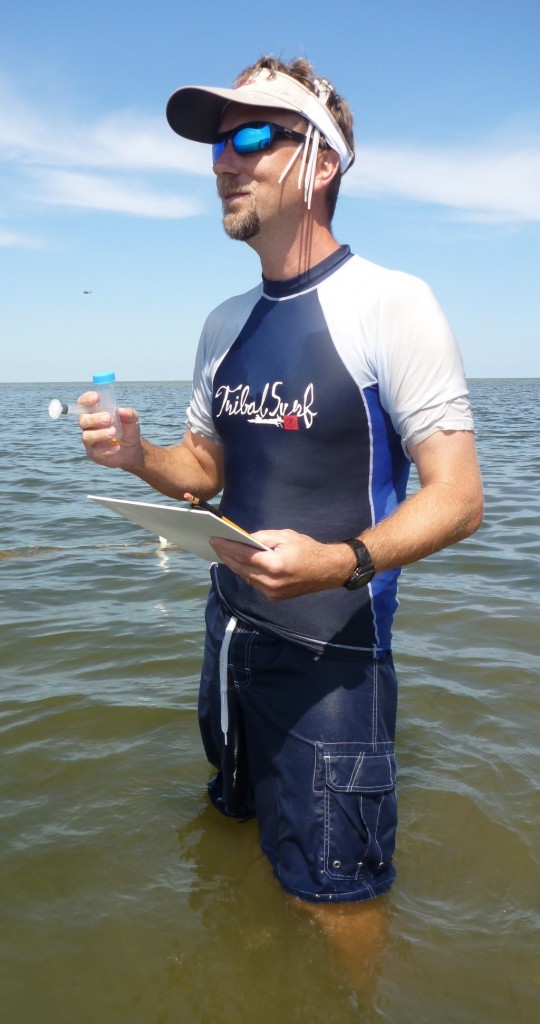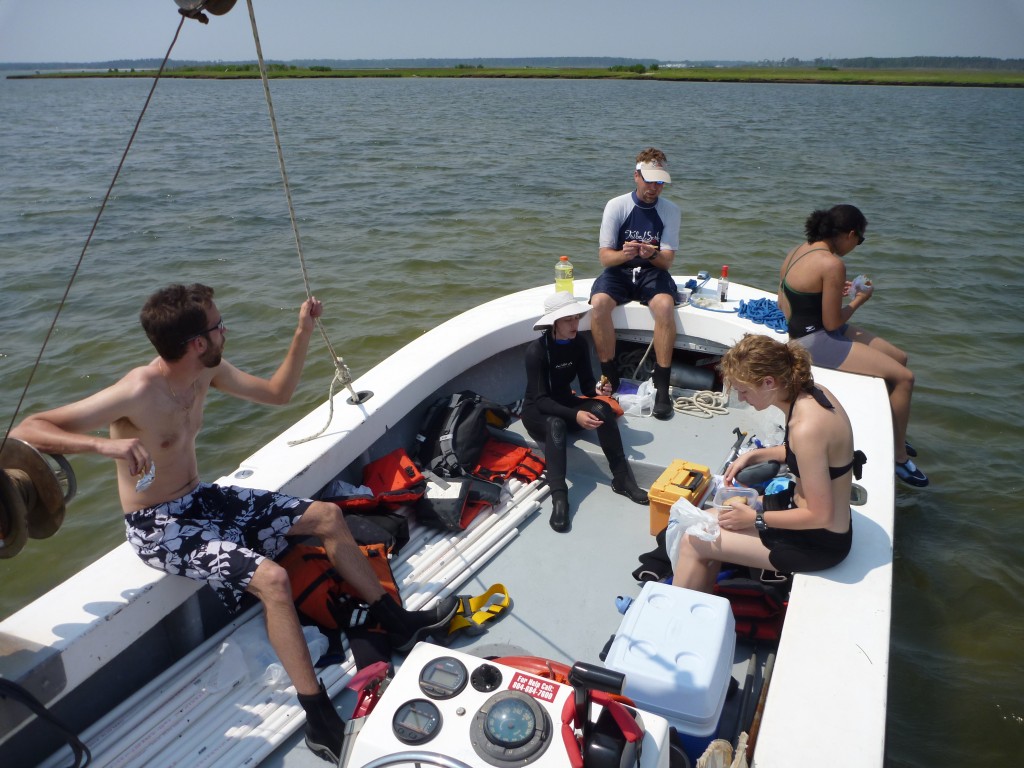A summer of adventure
By Akela Kuwahara, VIMS REU student summer 2011 (Humboldt State University)
Last week I earned my Invertebrate Zoology team at Humboldt State University 10 extra credit points for successfully identifying a gammaridean and caprellid amphipod, a mysid shrimp, and several Palmonetesshrimps! How, you ask? One word: ZEN.
This past summer I was in the REU program at VIMS working with Dr. Duffy’s Marine Biodiversity Lab. The ZEN project had just begun when I arrived in Virginia and I quickly set to work making experimental equipment and processing seagrass samples. Coastal Virginia looks nothing like the rocky California Coast where I currently go to school at Humboldt State University, nor like where I grew up on the Big Island of Hawaii.
I have had few experiences as enriching, educational, and career-focusing as my internship with the VIMS ZEN team. I had an up-close encounter with a juvenile terrapin who tried to nest in my hair, and an encounter with a sea nettle that wrapped my leg in a less than tender embrace. I became an expert at pouring cups of wet plaster, identifying a severed head or lone backside of the tiny amphipod Gammarus mucronatus, distinguishing between seagrasses Ruppia and Zostera, doing the sting-ray-shuffle, writing international UPS labels in the nick of time, and so much more.
Sadly, since my time at VIMS has ended, these skills have been poorly utilized. They have, however, given me a better understanding of marine ecology and the functioning of seagrass habitats, and they’ve earned me 10 extra credit points in Invertebrate Zoology! Emmett Duffy’s lab at VIMS is a craftily chosen group of people who have collectively helped to steer my interest in graduate studies towards subtidal ecosystems and their global presence and impact. I can’t wait to hear about where the ZEN is headed, and the progress that it has made. It was a summer well spent.
Photos by JE Duffy, PL Reynolds, JP Richardson
The ZEN Factory
By Paul Richardson, VIMS Marine Biodiversity Lab Manager
As Emmett’s lab manager in the Marine Biodiversity Lab at VIMS for the past 10 years there’s rarely been a dull moment. There is such an eclectic range of duties with this job that sometimes it’s hard to know what will come next. One day I may be driving a research vessel to field sites were we snorkel to collect samples in the Chesapeake Bay, the next I’m doing data analysis, or building materials for a mesocosm or field experiment, talking to a high school marine biology class, ordering lab supplies, or explaining to the woman at Wal-Mart that I really am buying all of their lingerie bags and knee high, queen sized, reinforced toe stockings for the purpose of science! The Zostera Experimental Network (ZEN) project has added yet more varied activities to the list. Never before have we conducted such an expansive project coordinating with 14 other research groups from around the States and the world!
First I have to say that none of this would have been possible without the hard work of the crew: volunteers Kara Gadeken, Megan Gyoerkoe, Jack Hawkins, and John Ray; our REU intern Akela Kuwahara and others; and the VIMS crew of Emmett Duffy, Pamela Reynolds, Erin Ferer, Jon Lefcheck, Nathan Bowman, and Elizabeth Bush. Marine ecology is a team sport and this crew knows how to play the game. Thanks! Also, I’m amazed to learn that it appears that all of the ZEN partners not only attempted but finished their experiments as well. As a first step, last winter we held a conference where representatives from all of the groups met in Williamsburg, VA to hash out a plan for the project. At this very productive meeting, it was great to meet all of the partners and certainly it was crucial to the success of the project. With Jim Grace’s seminars on structural equation modeling, Jim Thomas’ amphipod workshop, and all of the work sessions and other activities, the ZEN conference deserves its own dedicated post. As for me, after the meeting I worked with Emmett and Pamela to compute our materials needs, costs, vendors etc. for the network of ZEN experiments while also building on Matt Whalen’s work to formulate an ideal recipe and method for churning out the abundance of deterrent and control blocks that would be needed. I began conducting small field experiments to this end in the fall of 2010. In the spring after more trials we ultimately decided on a final mixture and we started churning them out. Continue Reading
This is science?
By Kara Gadeken, College of William & Mary undergraduate student
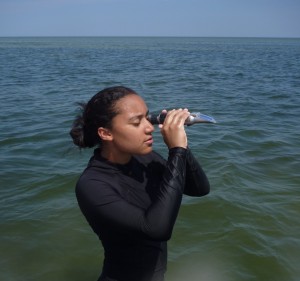
Undergraduate student Kara Gadeken takes water salinity measurements at Goodwin Islands, Virginia USA
Interning at VIMS during the hectic months when the ZEN project was at its peak was an experience that I will never forget.
The main reason that I wanted to take part in it was that, as an impassioned yet inexperienced college student, I had a reasonable knowledge base in biology but had no idea what it was like to actually do research, much less to be a part of such a grand-scale project as the ZEN. I approached Dr. Duffy at the suggestion of one of my professors at William and Mary, and luckily enough at this point his lab could use all of the help I could give.
I think the first thing that I realized while working in the Marine Biodiversity lab was that an insane amount of planning and preparation goes into research. Pamela had sticky notes and checklists and reminders all over everything in the lab, and two weeks of putting supplies together could count on one efficient day in the field. I also discovered that biologists, and especially experimental ecologists, almost have to have some engineering blood in them. In my first week at VIMS I sat in on a lab meeting to figure out how to design and construct cages to exclude predatory fish and crabs out in the seagrass beds. Time after time I heard, “How about this random thing? Hmm, I’m not sure that’ll work…How about this other random thing? Yeah, we can make something out of that!” Someone would hold up a piece of bent wire, some cable ties, bits of rope and mesh, some plastic plates. They hurled out idea after idea, trying to come up with something that could be constructed into a cage-like apparatus that would anchor into the sediment and withstand the waves. I remember stitching mesh together on an industrial sewing machine thinking, “This is science?” It didn’t take me long to realize that experiments are complicated. Not everything is perfect, and sometimes you have to work with what you’ve got, or make something new. Continue Reading

